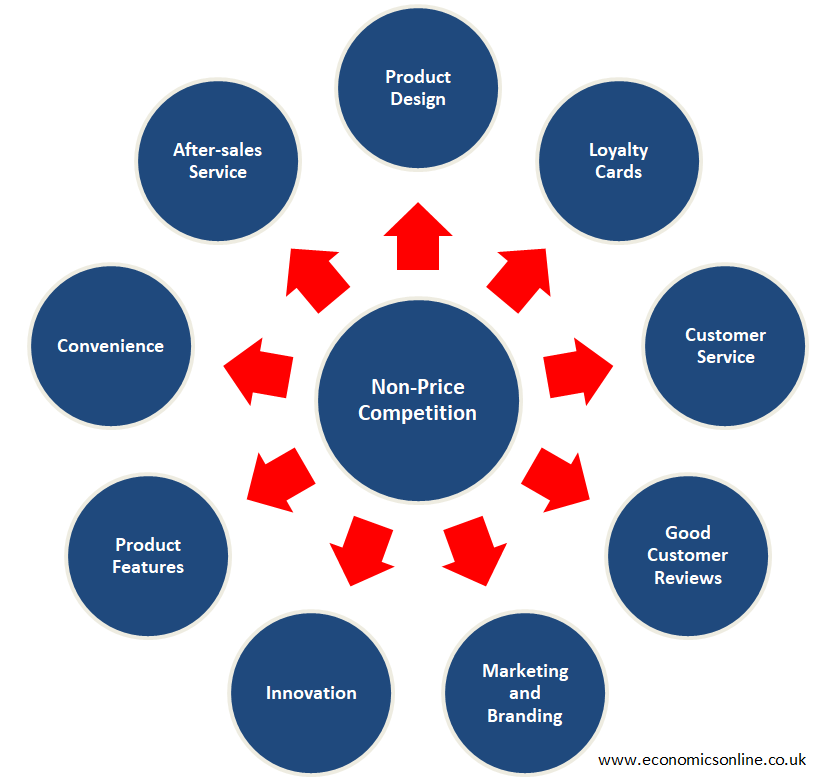Nonprice Competition: Gaining an Edge in the Market

Introduction
In today’s highly competitive business landscape, companies are constantly seeking ways to differentiate themselves from their rivals. While price has traditionally been a key factor in attracting customers, many businesses are now recognizing the importance of nonprice competition. Nonprice competition refers to the strategies and tactics employed by companies to gain a competitive advantage that is not based on price alone. In this article, we will explore the concept of nonprice competition and delve into various techniques that businesses can use to stand out in the market.
Nonprice Competition: What Is It?
Nonprice competition encompasses a wide range of factors that influence consumer behavior and buying decisions. It focuses on aspects other than the price of a product or service. Instead, it emphasizes the value proposition, brand image, product quality, customer service, innovation, and other factors that can sway customers to choose one company over another.
The Power of Nonprice Competition
In a crowded marketplace where numerous companies offer similar products or services, nonprice competition becomes crucial for establishing a unique position and attracting customers. By differentiating themselves through nonprice factors, businesses can create a loyal customer base, enhance brand recognition, and increase market share.
Utilizing Nonprice Competition Strategies
- Emphasize Product Differentiation
One effective way to engage in nonprice competition is by highlighting the unique features and benefits of your product or service. Clearly communicate how your offering stands out from the competition and addresses customers’ needs in a superior way. This can be achieved through effective marketing campaigns, informative product descriptions, and engaging demonstrations.
- Build a Strong Brand Identity
Building a strong brand identity is essential for nonprice competition. Create a brand that resonates with your target audience, conveys your company’s values, and establishes an emotional connection. Develop a compelling brand story and consistently communicate it across various marketing channels, such as your website, social media, and advertisements.
- Provide Excellent Customer Service
Exceptional customer service is a powerful nonprice competitive advantage. Train your employees to deliver outstanding service and ensure that every customer interaction is positive and memorable. Respond promptly to customer inquiries and resolve issues promptly. Happy customers are more likely to become brand advocates and recommend your business to others.
- Invest in Research and Development
To stay ahead in the market, it is essential to invest in research and development (R&D). Continuously innovate your products or services to meet changing customer demands and stay ahead of the competition. By introducing new features, improving quality, and exploring new technologies, you can maintain a competitive edge.
- Focus on Marketing and Advertising
Effective marketing and advertising campaigns are vital for nonprice competition. Develop compelling messages that highlight the unique aspects of your product or service. Utilize various marketing channels, Gaining an Edge such as social media, content marketing, influencer collaborations, and search engine optimization (SEO), to reach and engage with your target audience.

FAQs about Nonprice Competition
Q: What are some examples of nonprice competition?
Nonprice competition can take various forms. Examples include product differentiation, customer service excellence, brand reputation, innovation, exclusive distribution agreements, and effective marketing campaigns.
Q: How does nonprice competition benefit businesses?
Nonprice competition offers several benefits for businesses. It allows them to differentiate themselves from competitors, build customer loyalty, increase market share, command premium prices, and maintain profitability even in price-sensitive markets.
Q: Is nonprice competition applicable to all industries?
Yes, nonprice competition is relevant to businesses in all industries. While the specific strategies may vary, the underlying concept of creating a competitive advantage based on factors other than price is applicable across sectors.
Q: Can small businesses engage in nonprice competition?
Absolutely! Nonprice competition is not limited to large corporations. Small businesses can leverage their unique strengths, such as personalized customer service, niche expertise, and local community involvement, to compete effectively and attract customers.
Q: How can companies measure the effectiveness of their nonprice competition strategies?
Companies can measure the effectiveness of their nonprice competition strategies through various metrics, including customer satisfaction surveys, brand recognition studies, market share analysis, customer retention rates, and sales growth.
Q: Are there any risks associated with nonprice competition?
While nonprice competition offers numerous benefits, there are potential risks to consider. For example, investing heavily in R&D or marketing campaigns can be costly. Additionally, if a company fails to deliver on its promises or experiences negative publicity, it may damage its brand reputation.
Conclusion
In an increasingly competitive business environment, nonprice competition has become a crucial aspect of gaining a competitive edge. By focusing on factors other than price, such as product differentiation, brand identity, customer service, innovation, and marketing, businesses can attract and retain customers, stand out from the competition, and drive long-term success. Embracing nonprice competition is not only essential but also an opportunity for companies to establish themselves as leaders in their respective industries.





